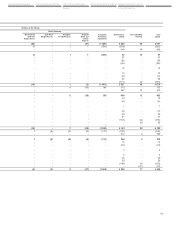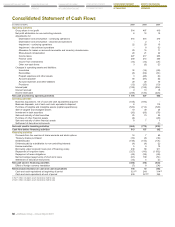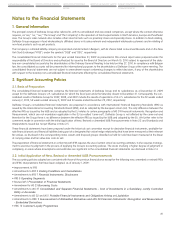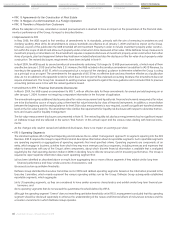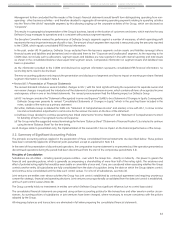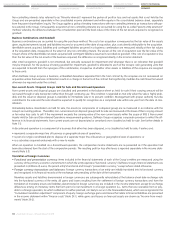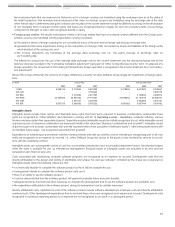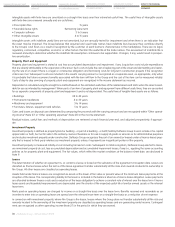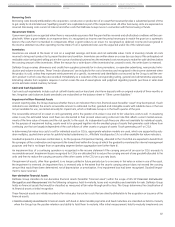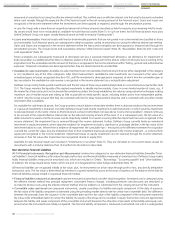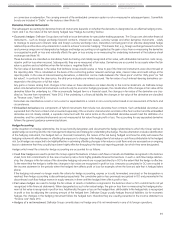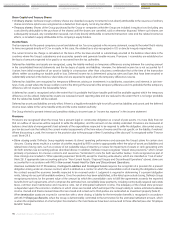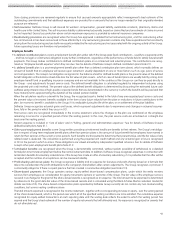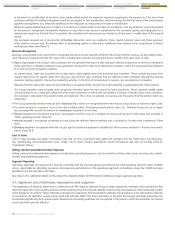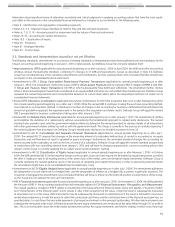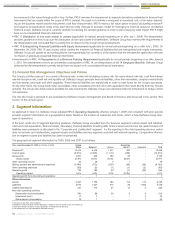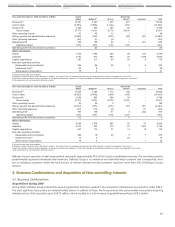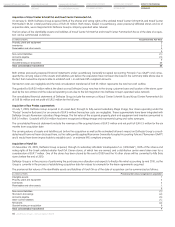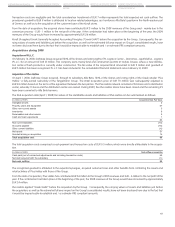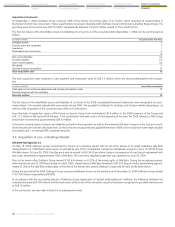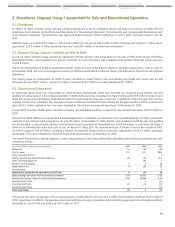Food Lion 2009 Annual Report Download - page 93
Download and view the complete annual report
Please find page 93 of the 2009 Food Lion annual report below. You can navigate through the pages in the report by either clicking on the pages listed below, or by using the keyword search tool below to find specific information within the annual report.
89
SUMMARY STATUTORY ACCOUNTS
OF DELHAIZE GROUP SA
HISTORICAL FINANCIAL OVERVIEW CERTIFICATION OF RESPONSIBLE
PERSONS
REPORT OF THE STATUTORY AUDITOR
SUPPLEMENTARY INFORMATION
on conversion or redemption. The carrying amount of the embedded conversion option is not re-measured in subsequent years. Convertible
bonds are included in “Debts” on the balance sheet (Note 18).
Derivative Financial Instruments
The subsequent accounting for derivative financial instruments depends on whether the derivative is designated as an effective hedging instru-
ment, and if so, the nature of the item being hedged (see “Hedge Accounting” below).
tEconomic hedges: Delhaize Group does not hold or issue derivatives for speculative trading purposes. The Group uses derivative financial
instruments - such as foreign exchange forward contracts, interest rate swaps, currency swaps and other derivative instruments - solely
to manage its exposure to interest rates and foreign currency exchange rates. Derivatives not being part of an effective designated hedge
relationship are therefore only entered into in order to achieve “economic hedging.” This means that, e.g., foreign exchange forward contracts
and currency swaps are not designated as hedges and hedge accounting is not applied as the gain or loss from re-measuring the derivative
is recognized in profit or loss and naturally offsets the gain or loss arising on re-measuring the underlying instrument at the balance sheet
exchange rate (Note 19).
These derivatives are classified as mandatory held-for-trading and initially recognized at fair value, with attributable transaction costs recog-
nized in profit or loss when incurred. Subsequently, they are re-measured at fair value. Derivatives are accounted for as assets when the fair
value is positive and as liabilities when the fair value is negative (Note 19).
The fair value of derivatives is the value that Delhaize Group would receive or have to pay if the financial instruments were discontinued at
the reporting date. This is calculated on the basis of the contracting parties’ relevant exchange rates, interest rates and credit ratings at the
reporting date. In the case of interest-bearing derivatives, a distinction can be made between the “clean price” and the “dirty price” (or “full
fair value”). In contrast to the clean price, the dirty price includes any interest accrued. The fair value of such interest-bearing derivatives cor-
responds to the dirty price or full fair value.
Any gains or losses arising from changes in fair value on these derivatives are taken directly to the income statement. As Delhaize Group
enters into derivative financial instruments contracts only for economic hedging purposes, the classification of the changes in fair value of the
derivative follow the underlying (i.e. if the economically hedged item is a financial asset, the changes in fair value of the derivative are clas-
sified as “Income from investment,” Note 29.2; if the underlying is a financial liability, the changes in fair value of the derivative are classified
as “Finance costs,” Note 29.1).
Derivatives are classified as current or non-current or separated into a current or non-current portion based on an assessment of the facts and
circumstances.
tEmbedded derivatives are components of hybrid instruments that include non-derivative host contracts. Such embedded derivatives are
separated from the host contract and accounted separately, if the economic characteristics and risks of the host contract and the embedded
derivative are not closely related, a separate instrument with the same terms as the embedded derivative would meet the definition of a
derivative, and the combined instruments are not measured at fair value through profit or loss. The accounting for any separated derivative
follows the general guidance summarized above.
Hedge Accounting
At the inception of a hedge relationship, the Group formally designates and documents the hedge relationship to which the Group wishes to
apply hedge accounting and the risk management objective and strategy for undertaking the hedge. The documentation includes identification
of the hedging instrument, the hedged item or (forecast) transaction, the nature of the risk being hedged and how the entity will assess the
hedging instrument’s effectiveness in offsetting the exposure to changes in the hedged item’s fair value or cash flows attributable to the hedged
risk. Such hedges are expected to be highly effective in achieving offsetting changes in fair value or cash flows and are assessed on an ongoing
basis to determine that they actually have been highly effective throughout the financial reporting periods for which they were designated.
Hedges which meet the criteria for hedge accounting are accounted for as follows:
tCash flow hedges are used to protect the Group against fluctuations in future cash flows of assets and liabilities recognized in the balance
sheet, from firm commitments (in the case of currency risk) or from highly probable forecast transactions. In such a cash flow hedge relation-
ship, the changes in the fair value of the derivative hedging instrument are recognized directly in OCI to the extent that the hedge is effective.
To the extent that the hedge is ineffective, changes in fair value are recognized in profit or loss. Amounts accumulated in OCI are recycled in
the income statement in the periods when the hedged item affects profit or loss (for example, when the forecast sale that is hedged takes
place).
If the hedging instrument no longer meets the criteria for hedge accounting, expires or is sold, terminated, exercised, or the designation is
revoked, then hedge accounting is discontinued prospectively. The cumulative gain or loss previously recognized in OCI and presented in the
discontinued cash flow hedge reserve in equity remains in there until the hedged item affects profit or loss.
tFair value hedges are used to hedge the fair values of assets or liabilities recognized in the balance sheet or firm commitments not yet
recognized in the financial statements. When designated as such a fair value hedge, the gain or loss from re-measuring the hedging instru-
ment at fair value is recognized in profit or loss. Additionally, the gain or loss on the hedged item, attributable to the hedged risk, is recognized
in profit or loss by adjusting the carrying amount of the hedged item. Delhaize Group usually hedges financial liabilities. As for economic
hedges, the changes in the hedging instrument follow the hedged item; therefore they are usually presented in the income statement as
“Finance cost” (Note 29.1).
tHedges of a net investment: Delhaize Group currently does not hedge any of its net investments in any of its foreign operations.


